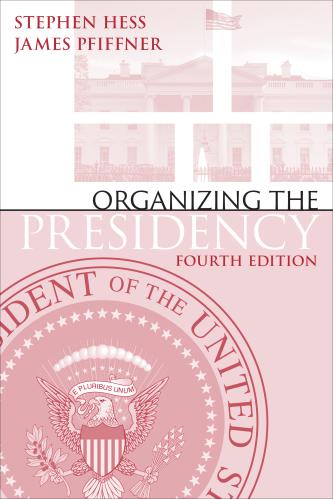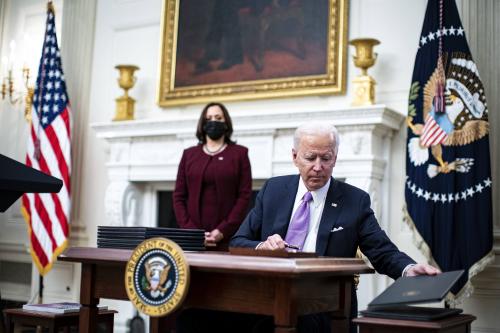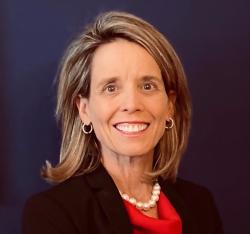This piece looks specifically at personnel turnover within the first year of the Biden administration. To keep up with current levels of staffing changes within the executive branch, please see Brookings’s regularly updated tracker.
Over the course of its first year, President Biden’s team faced several well-documented challenges—but staffing the White House was not one of them. Although he had a truncated transition due to the General Services Administration’s unwillingness to “ascertain” that Joe Biden had won the election, a record breaking 1,136 appointees were sworn in on Inauguration Day. This study focuses primarily, but not exclusively, on turnover in the president’s “A-Team,” defined as senior executive-office positions that do not require Senate confirmation.[1]
During the first year, some level of turnover is expected and reflective of a new White House adapting and adjusting to the demands of governing. Too much turnover, however, inhibits a president’s ability to govern and may be a symptom of a larger problem in the new administration. The Biden administration’s first-year turnover was one of the lowest of the past six administrations and may reflect the influence of experience and a professional transition operation.[2] Having worked in the White House enables a new staff to avoid the pitfalls that plague those without that valuable experience. Additionally, prioritizing staff recruitment during the transition can lay a foundation for a stable environment.
Approach: How to think about staff turnover
What counts as turnover, and why does it matter? For the purposes of this study, turnover refers to a vacancy created through promotion, resignation, or firing. Any of these movements introduce inefficiency as they require resources (hiring, vetting, and training) and likely increase the workload for those who remain. Staff members move on for a variety of reasons, and the impact of a high-level departure varies a great deal. Senior advisors who possess a close relationship with the chief executive are often irreplaceable, while those who deal with the press, Congress, or interest groups, for example, are more easily replaced. Nevertheless, those who serve on the A-Team are, by definition, critical participants in the presidency, such that any departure has an impact on White House operations.
Turnover also means the loss of the departee’s personal relationships and network. Much of the work of the White House is promotion and coordination across the federal government, interest groups, and key constituencies. No amount of training can transfer relationships from one staff member to another, demonstrating yet another downside to staff departures. Too much turnover can hinder a president’s ability to implement their agenda.
Finally, in the case of high-level departures, a single exit often results in a cascade of junior staff leaving as well. Some may leave because their mentor departed or because the new leader prefers to staff an office with her or his favored set of individuals. Regardless, it is important to recognize that a single departure is sometimes just the proverbial tip of the iceberg.
Methodology
Determining the composition of the president’s A-Team—the most influential staff members—is highly subjective. However, I have adopted a process that relies on a consistent source and seeks to remove as much subjectivity as possible. From 1981 to 2009, National Journal published a special edition called “Decision Makers” at the start of each new administration. A group of reporters would spend the first few months of a new administration trying to determine who among the new arrivals might be most influential. The special edition included staff biographies and often pictures of these “Decision Makers.” These five listings included an average of 60 staff members from the Executive Office of the President (EOP), and identified individuals working in the White House Office, the Council on Environmental Quality, the National Security Council, and select members of the vice president’s staff, among other entities. While there was variation from administration to administration in terms of which positions were included, most were recurring positions. Using a variety of resources, I was able to track the tenure of these influential staff members over the course of the first term in office (and second terms when the opportunity availed itself).
Since National Journal stopped publishing the “Decision Makers” special editions after 2009, I partnered with Bloomberg journalist Madison Alder in 2017 to create a Trump A-Team. We carefully compiled every job title from the existing editions, determined its frequency, and then analyzed the Trump appointments looking for similar, high-level positions. Each “Decision Maker” edition also included new positions (19, on average, for the five first years), and we included new entities within the Trump administration. Presidents, eager to put their mark on the White House, tend to add a small number of new offices or create new positions within the top tier of their staff. Pressing issues like the pandemic or a financial crisis require a vigorous government response and may lead to the establishment of a new entity in the EOP. I followed the same practice from 2017 to create the Biden A-Team, matching Biden staff members to those positions named in National Journal and identifying significant new positions and entities.
Note that this analysis focuses only on how long the initial “Decision Maker” stays in their original appointment; once they leave, that data point falls out of the sample. I do not track the successor or any other staff changes related to that position. I am interested in how long the initial team stays intact. This research has also been supplemented by numerous news reports and off-the-record discussions with those familiar with the Biden transition and administration.
Turnover within the first year of Biden’s A-Team
Set out below is the level of turnover across the first term of President Biden and his six predecessors.
The level of A-Team turnover in the first year of the Biden administration, 8%, ranks as the third-lowest rate among the seven presidents dating back to Reagan. Only presidents George H.W. Bush and George W. Bush had a lower rate of turnover. There was slightly higher turnover in the Obama and Clinton administrations. Compared to Biden, Reagan had more than double the turnover, and the Trump administration had more than four times the percent of turnover during the first year. The 8% turnover rate translates to five A-Team departures out of 66 positions, suggestive of a highly stable staff.
Digging more deeply into the five departures, one can see that they come from a range of offices and departed for distinctly different reasons. There were two departures holding the highest rank of “Assistant to the President”: Catherine Russell (director, White House Office of Presidential Personnel) and Julissa Reynosa Pantaleon (chief of staff, First Lady Dr. Jill Biden). The two departed for different professional pursuits: Russell became the executive director of UNICEF and Reynoso Pantaleon was confirmed by the Senate to be the U.S. Ambassador to Spain. A third high-level departure was Anita Dunn, a special government employee (a designation she requested), who was “senior advisor to the president.” Dunn’s departure occurred seven months after inauguration, but it is important to note that she never sought to join the administration. When pressured, she agreed to stay for a brief stint. The fourth departure was Jessica Hertz, staff secretary and deputy assistant to the president who moved to the private sector. The fifth departure—but first chronologically—was Deputy Press Secretary TJ Ducklo, a forced resignation due to unprofessional conduct that occurred less than a month after inauguration.
In stark contrast, President Trump lost three senior staff members within the first three weeks in office, and nine additional A-Team members by August 2017. Of the 12 Trump departures, five came from the National Security Council, suggesting that it was undergoing serious restructuring. By the end of the first year, Trump’s first-year turnover grew as high as 23 A-Team departures.
In some ways, the low level of turnover during the Biden administration’s first year highlights just how unusual the staff situation was during the Trump administration. Nevertheless, any departure causes some disruption. The Biden team was only in office for just over three weeks when TJ Ducklo was forced to resign. Given the negative press accounts explaining his behavior, the Biden team was fortunate that his was the only departure of this type. A second departure that received a great deal of negative press was that of Staff Secretary Jessica Hertz. Her departure generated numerous speculative stories about her prior employment with Facebook, suggesting that it may have been the reason for her departure. According to Leadership Connect, a website that monitors the comings and goings of all federal staff, there have been six more departures in the staff secretary’s office since Hertz left the White House. For an office of roughly nine members, this illustrates how the impact of an A-Team departure can lead to a major exodus, putting strain on the Presidential Personnel Office as well as other White House offices that work closely with the staff secretary.
In sum, the first year included a forced resignation (Ducklo), a predictable departure (Dunn), a sudden departure that went unexplained (Hertz), a voluntary resignation that had been reported on roughly five months before (Russell), and a promotion to a more prestigious governmental position (Reynoso Pantaleon). The departures were far from concentrated in a single office, but rather came from a broad swath of offices and for a variety of reasons.
Apart from the low level of A-Team turnover, there were two curious vacancies throughout the first year in office. The president failed to appoint leaders to two key jobs: director of the Office of Management and Budget (OMB) and the administrator of the Office of Information and Regulatory Affairs (OIRA). Both jobs require Senate confirmation and, while the White House withdrew Neera Tanden’s nomination for OMB director in March 2021, there was an unusual delay. The Biden White House did not nominate a successor, Deputy Director Shalanda Young, until late November—roughly eight months later. In the case of OIRA, they have yet to nominate anyone for what is an extremely important position in the White House. According to the Revolving Door Project, this innocuously named office has a “unique mandate to review nearly all federal regulations … and choose to approve, stall, or kill them.” This vacancy is all the more surprising given that, on the first day of his administration, President Biden issued a memorandum directing the government to modernize the regulatory review process.
Regression to the mean
Staff turnover in the Biden administration represents a return to normalcy, or a regression to the mean as statisticians like to think of it. In accounting for the high level of stability, it seems reasonable to focus on two factors: the extensive public-service experience that this group of White House staff members possesses, and the professionalism and efficiency of the presidential transition.
In regard to government experience, I have conducted a related study of the top 100 Biden staff members for the Miller Center at the University of Virginia. In it, I calculated that a full 77% have prior executive-branch experience. That is an astoundingly high number and no doubt reflective of the president himself, an individual who possesses a lengthy career in the Senate and served as vice president. While this crucial government experience may have allowed staff members to avoid some pitfalls, it did not insulate the White House from missteps or controversial decisions as evidenced by the chaotic withdrawal from Afghanistan and major legislative losses on signature programs. Nevertheless, there have been fewer incidences of rookie mistakes, embarrassing leaks, and major staff shuffling—all factors that have produced an overall sense of steadiness.
Second, the Biden transition team was top notch and paved the way for a well-oiled personnel operation. Led by a former senator and Biden confidant, Ted Kaufman, they assembled a team and started preparations in spring of 2020. Transition scholar Martha Joynt Kumar notes that the transition team was composed of experienced, motivated professionals who anticipated obstacles and prepared for the worst. One particular achievement is relevant to this study: The transition team conducted 8,000 interviews during the presidential transition. This effort represented a major allocation of resources and reflected the transition’s personnel priorities. Anticipating a slow-moving Senate, transition leaders focused their attention on the thousands of other presidential appointments that did not require Senate confirmation.[3] Such early and earnest preparation likely contributed to staff stability during President Biden’s first year, despite a year characterized by highly visible setbacks and struggles to get nominees confirmed and legislation passed. Looking back, the transition’s accomplishments followed by two key Senate victories in run-off elections that paved the way for Democratic majorities in both houses of Congress, may have raised expectations to unrealistic levels. Adversity aside, the first set of personnel decisions created a highly stable staff at the very least.
LOOKING AHEAD
The stability and low level of staff drama during the Biden White House portend a similar second year. In many respects, the low-key approach has been established and set the stage for the remainder of the term (barring any major crises or catastrophes). Despite this foundation, history indicates that there will be an uptick in departures during year two.
With the midterm elections in the offing as well as the extreme difficulty enacting President Biden’s legislative priorities, it will be understandable if more staff depart in the second year. Recall that many of these senior officials also worked on the presidential campaign—they have put in well over one year of hard work under high pressure. In addition, many are veterans of the Obama White House and are keenly aware of the costs imposed by these demanding jobs. Turnover is par for the course in any White House, but quality management, maintaining a professional environment and having succession plans in place can minimize the inefficiencies and disruption.
Footnotes
- The pace of Senate confirmations was at a historic low and inhibited the Biden administration’s ability to put permanent staff members in place across the executive branch. (Back to top)
- Please note that recent media attention to departures from the vice president’s office is beyond the scope of this research. My central source, the National Journal “Decision Makers” editions, only included a small number of positions from the vice president’s staff simply because the focus was the president’s A-Team. In identifying the most influential advisors serving the president, the sample, by definition, does not include a large number of staff from the vice president’s office. (Back to top)
- Martha Joynt Kumar, “Joseph Biden’s Effective Presidential Transition: “Started Early, Went Big,” Presidential Studies Quarterly, Vol. 51, Issue 3, September 2021, p. 2. (Back to top)







Commentary
‘A-Team’ turnover in the Biden administration: A return to normalcy
Thursday, January 20, 2022